As part of the B.S. degree program, chemistry and biochemistry students are required to complete a minimum of 4 credits of undergraduate research (Chem 498) over at least 2 semesters under the direction of a faculty mentor. For chemical education students, this is reduced to 2 credits since they additionally complete an Action Research Project as part of their education coursework.
Students are then required to take Chem 490 where they will present their original research to the faculty via a seminar and write a research report or prepare a written manuscript in the style and format of a scientific journal. Presentation of this research at an appropriate professional scientific meeting is also encouraged, but not required.
How do you develop a research project
Luke Knutson, Chemistry and Biochemistry double major in 2023 (graduating with honors) talks about his research experience at SDSU in the lab of Dr. Darci Fink.
Opportunities to present your research
- Undergraduate Research, Scholarship and Creative Activity Day (URSCAD)
- Typically held in April, students have opportunities on campus to present their research in a poster-style format where they are judged by faculty members. The top poster in each subject category are eligible for award recognition.
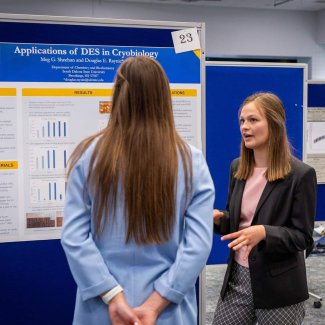
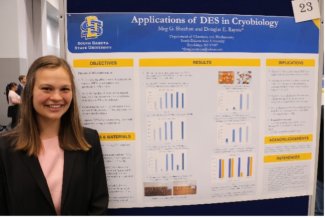
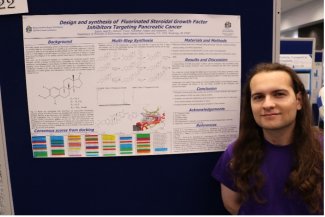
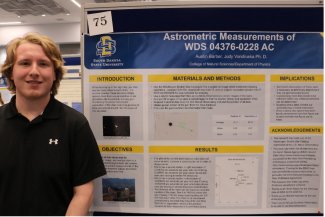
Presentations/Publications
Many undergraduate students co-author papers for professional journals which exemplifies the impact of involving undergraduates in research early in their college career.
RAWC Lab
The RAWC Lab under the direction of assistant professor, Dr. Rachel Willand-Charnley is one lab that accepts undergraduate students for research projects.
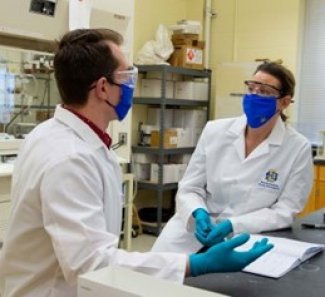
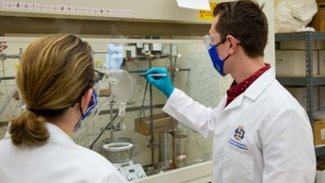
Published undergraduate students as co-authors on journal papers and/or conference posters featuring the undergraduate research they did with their research mentor, Dr. Rachel Willand-Charnley:
- Timothy Paris, (2021 – B.S. Chemistry and Biochemistry with Honors). After graduation, Timothy Paris went on to work as a research associate at Stanford University’s Medicinal Chemistry Knowledge Center and was recently accepted to begin the M.D./Ph.D. program at Yale University.
Eric Sundall (2021 – B.S. Chemistry and Biochemistry with Honors)
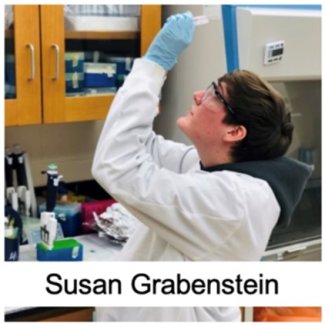
- Jillissa Taubel (2020-B.S. Chemistry)
- Susan Grabenstein (2021-B.S. Biochemistry)
Financial Support for Undergraduate Research
To support the undergraduate research requirement, students have the opportunity to apply for a research fellowship to support research opportunities, typically over the summer semester. These fellowships have been created by alumni and donors to the university to support students in having those invaluable research opportunities. It is expected that the Research Fellows will devote themselves full-time to the project during the summer months.
Each fellowship offers:
- $5000 stipend
- $1000 for laboratory chemical and supplies
Identifying a Research Project: You should seek a research project that fits both your current interests and your long-term career goals. Identify a faculty member whose work interests you by reviewing the professor's research programs on the department website or discussing research opportunities with your course instructors or advisor. When you find a project of interest, feel free to contact the professor. Next, meet with the professor and discuss research opportunities. If a good match exists, you and the professor will prepare a research outline to guide the project.
Application Requirements (deadline is typically mid-spring semester):
A complete application consists of the following:
- The cover sheet (example below)
- A project proposal prepared with the faculty member with whom you want to work (maximum length: 2 pages)
- A letter (maximum length: 2 pages) explaining your interest in chemistry or biochemistry, your career goals, and your expectations for involvement in a research project
- A letter of recommendation from your proposed research mentor.
Interested students should submit complete applications via email to Stephanie Jensen, program assistant.
Summer Undergraduate Research Fellowship in Chemistry/Biochemistry/Chemistry Education
COVER SHEET
Student Name:
YOUR PROJECT
Title of Proposed Research Project:
Proposed Research Mentor:
Abstract of Proposed Research (100 words max.):
YOUR BACKGROUND
List all university-level chemistry/biochemistry courses you have taken (including this semester):
List all additional university-level science courses you have taken (including this semester):
List any relevant laboratory experience you have had:
YOUR APPLICATION
Attach your two-page project description, two-page letter of research and career interest, and recommendation letter from the faculty research mentor (the letter may also be sent directly by the faculty member to Stephanie.Jensen@SDState.edu).
Your project description will be evaluated based of the following criteria:
- Overall quality
- Written in clear, concise, convincing manner
- Project is scaled appropriately for summer research
- Demonstrates a knowledge of the underlying chemistry
- Clearly articulated research hypothesis
- Appropriateness of research approach
- Reasonable outcome presented
Fellowships
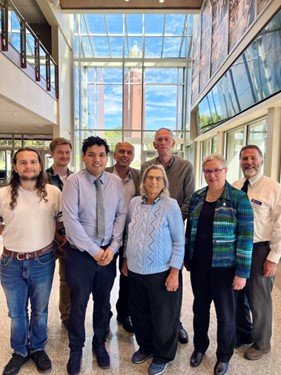
East Family Undergraduate Research Fellowship, funded by Mary and Jack East. The fellowship is for a 10-week research experience and is open to all chemistry, chemistry education, or biochemistry majors.
Biography of Donor: Mary East grew up on a farm near Ipswich, South Dakota and came to South Dakota State University in 1967, majoring in chemistry. Mary was interested in chemistry after her high school chemistry course sparked her curiosity and she found the courses at SDSU to be exciting. In deciding to give back to SDSU, Mary shared that in her many years since college, her fond memories and the success she found after graduation inspired her to help other students see an opportunity to dream bigger. Mary graduated from SDSU in 1971 and worked as a chemistry for General Electric Company in Philadelphia for four years. During that time, she received a master’s degree in chemistry at Drexel University in Philadelphia. In 1975, Mary entered medical school at the University of South Dakota for two years and then University of Minnesota for two years, graduating in 1979. After medical school, she moved to Ann Arbor for a residency in general surgery and stayed following the completion of her residency in 1984, with an appointment at the University of Michigan and practicing general surgery at the Veterans Medical Center. Mary retired in 2014. Mary met and married her husband, Jack East, during residency; he is a senior research scientist in electrical engineering at the University of Michigan. Mary and Jack have two adult sons. In September 2022, Mary and Jack returned to meet some of the undergraduate students who were awarded the East Family Fellowships in Chemistry and Biochemistry and spent the summer in advanced research with faculty mentors in their labs. The following month, Mary passed away.
Tanaka Undergraduate Research Fellowship, funded by John and Patty Tanaka. The fellowship is for a 10-week research experience and priority for this fellowship is given to students in their second to fifth semesters at SDSU majoring in chemistry, biochemistry, or chemical education.
Biography of Donor: Dr. John Tanaka was hired by SDSU in 1956 after completion of his Ph.D. from Iowa State University and his undergraduate degree from UCLA in 1951. He received a grant from the Research Corporation of New York to support his research at SDSU. He resigned in June 1963 to accept a post-doctoral fellowship at the University of Pittsburgh. He went to the University of Connecticut in 1965 and retired from there as a professor of inorganic chemistry in 2005. Dr. Tanaka married Patty Ellwein (SDSU class of 1959) from Watertown, SD.
While at the University of Connecticut, Dr. Tanaka served as director of the honors program for 22 years, taught organic and inorganic chemistry, specialized in inorganic chemistry and polymer chemistry, filed two patents, published five books and monographs and had over 250 articles and conference papers published.
Following his retirement, Dr. Tanaka and his wife Patty created this fellowship to encourage SDSU undergraduates pursuing chemistry or biochemistry to engage in the SDSU research community.
Twila Paulsen Okken/Guss Family Research Fellowship, funded by Twila Okken. The fellowship is for a 10-week research experience and is open to all chemistry, chemistry education, or biochemistry majors.
Biography of Donor: Twila Okken was born and raised in the Midwest. She earned B.S. and M.S. degrees from South Dakota State University and was a research chemist for the Archer Daniels Midland Company in Minneapolis for 22 years. Okken began her career testing milk samples during the Depression, according to the book “Mothers and Daughters of Invention: Notes for a Revised History of Technology”. A published researcher, she received three patents for soybean products during the 1960’s. During her professional career, she was very active in Zonta Club of Minneapolis, an international organization for executive women, and Sigma Delta Epsilon, a fraternity for women in science.
Later in life, Twila married Charlie Okken and they moved to San Bruno, California as newlyweds in 1967. She was active in garden club projects, arts and crafts, and was junior garden club leader for many years. She passed away in August of 2006.

